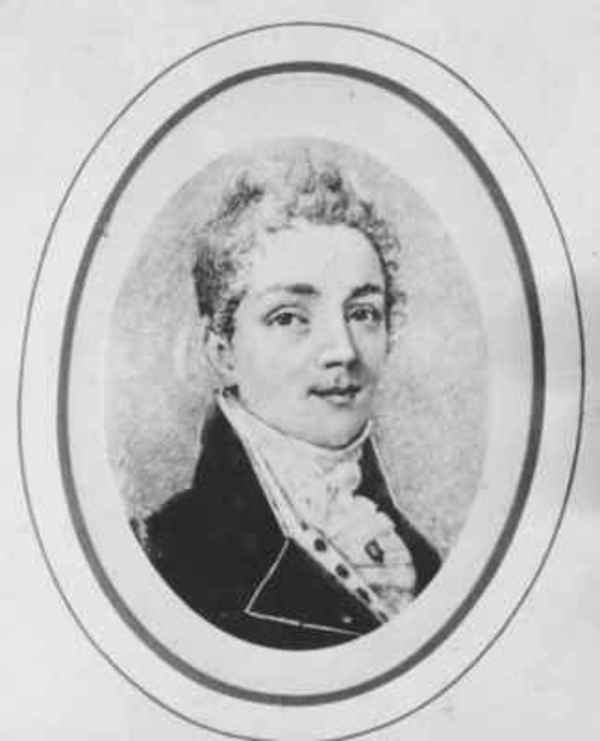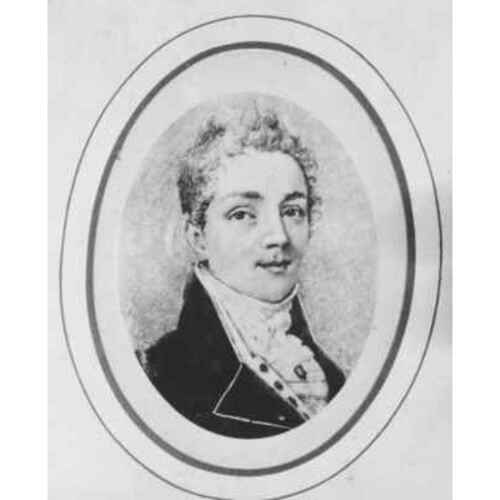
Source: Courtesy of Wikimedia Commons
STEELE, ELMES YELVERTON, naval officer, farmer, politician, and public servant; b. 6 Feb. 1781 at Colford (Coleford), Gloucestershire, England, one of ten children of Elmes Steele, md, and Mary Benfield; m. first, in 1809, Elizabeth Seeley Coucher, by whom he had six children, and secondly, in 1847, Anne MacIan Macdonald, by whom he had six children; d. 6 Aug. 1865 in Medonte Township, Canada West.
Military careers were common in the Steele family. Five of Elmes’ six brothers entered the army or navy and his uncle, Samuel, had served in Canada with Jeffery Amherst* in 1760. Not unnaturally, Elmes chose a career in the Royal Navy, entering as an officer cadet in 1798. He served with distinction on several ships during the Napoleonic wars and rose to the rank of captain. He was mentioned in dispatches for his part in a raid on the Spanish coast, escorted a convoy to Quebec in 1805 as lieutenant of the Mercury, and served as gunnery officer on board the Leopard when she fired on the United States ship Chesapeake in June 1807.
After Waterloo Steele went on half pay and settled with his family in France. In 1830, while he was in England exercising his right (granted in 1812) to vote as a freeman of the city of Gloucester, revolution erupted in Paris and his family joined him in England. In 1832 Steele came to Canada with his son John to claim land which had been offered to British officers. He selected a 1,000 acre site in Medonte Township north of Lake Simcoe and was joined by the rest of his family in 1833.
In 1837 Steele mustered volunteers in Medonte to help suppress the rebellion led by William Lyon Mackenzie. All those who could bear arms marched to Barrie, where guns were issued, and then to Newmarket, where news of the rebels’ defeat reached them. Steele and a friend continued to Toronto on business, passing the smouldering ruins of John Montgomery*’s tavern on the way. Steele retired from the navy with the rank of commander in 1838 and, although he was a lieutenant-colonel of the Simcoe County militia for two decades, he concentrated on civilian matters.
Appointed magistrate in 1833, he was also particularly active in promoting public works. In an 1839 petition Steele and others argued that a water route connecting Lake Huron and the Bay of Quinte by way of the Severn River, Lake Simcoe, and the Trent River would open up lands for settlement and increase the value of grain production and export. It would also provide a shorter, cheaper route for trade between Lower Canada, Upper Canada, and the rapidly developing western states of the United States, provide construction jobs for immigrant labourers, and create a secure communications route between the Canadian Great Lakes in the event of war with the United States.
On 15 Oct. 1839 Steele was elected chairman of a meeting at Finch’s Tavern on Yonge St at which Reformers approved the recommendation for responsible government made by Lord Durham [Lambton*]. A Tory mob led by the sheriff of the Home District, William Botsford Jarvis, broke up the meeting. The death of at least one unarmed Reformer caused a scandal in the province and Steele gained a reputation as a staunch Reformer, although he had taken no part in provincial politics until that time. As a result, Reformers strongly supported Steele’s candidacy in Simcoe in the election of 1841. He promised to further local interests such as roads and pensions, of particular interest to settlers many of whom were like himself former military men. His Tory opponent, William Benjamin Robinson*, he had also denounced in 1839 as an intimate of the Family Compact whose “misdeeds” he listed: “prodigality terminating in the bankruptcy of the province . . . arbitrary proceedings . . . insufferable pride and presumption. . . .” Steele defended the yeomanry who had been branded “with the stigma of rebel,” and supported the union of the Canadas because it would “reduce to their proper level in the social circle every member of the dominant faction.” In the assembly Steele worked successfully for a good road from Toronto to Orillia, and campaigned for the restoration of pensions which army and navy veterans had commuted to get a start in Canada. He did not run in the election of 1844, having been branded by local interests as a follower of Lord Sydenham [Thomson*] rather than of Robert Baldwin*. Instead he restricted his efforts to his work as jp, to the promotion of non-political local projects, and support of the Anglican church he had endowed in Medonte. In his later years he lived for a time on what was to be the site of Orillia.
Steele’s sons, especially Major-General Sir Samuel Benfield Steele*, maintained the family’s tradition of distinguished military and civilian service.
A collection of materials supplied by Harwood Steele to the DCB has been useful in the preparation of this biography. It consists of notes on and typed copies of manuscript sources, and photocopies of relevant secondary sources, including Katherine Day, “The letters of Capt. Steele’s daughters” (unpublished paper delivered to the Orillia Hist. Soc., 19 March 1953). Mirror (Toronto), 26 Feb. 1841. Elmes Steele, To W. B. Robinson, esq., M.P.P. (broadsheet, 30 Oct. 1839). The Toronto almanac and royal calendar, of Upper Canada . . . (Toronto), 1839. A. F. Hunter, A history of Simcoe County (2v., Barrie, Ont., 1909; repr. 1v. in 2 pts., 1948). Elmes Henderson, “The public services, &c., of Commander Elmes Steele, R.N.,” OH, XXIV (1927), 373–80. Orillia Packet (Orillia, Ont.), 26 March 1908. J. C. Steele, “Reminiscences of a pioneer,” Simcoe County Pioneer and Hist. Soc., Pioneer Papers (Barrie, Ont.), no.4 (1911). M. E. Wilson, “The Steele family,” OH, XXXIV (1942), 117–20.
Cite This Article
Ronald J. Stagg, “STEELE, ELMES YELVERTON,” in Dictionary of Canadian Biography, vol. 9, University of Toronto/Université Laval, 2003–, accessed December 31, 2025, https://www.biographi.ca/en/bio/steele_elmes_yelverton_9E.html.
The citation above shows the format for footnotes and endnotes according to the Chicago manual of style (16th edition). Information to be used in other citation formats:
| Permalink: | https://www.biographi.ca/en/bio/steele_elmes_yelverton_9E.html |
| Author of Article: | Ronald J. Stagg |
| Title of Article: | STEELE, ELMES YELVERTON |
| Publication Name: | Dictionary of Canadian Biography, vol. 9 |
| Publisher: | University of Toronto/Université Laval |
| Year of publication: | 1976 |
| Year of revision: | 1976 |
| Access Date: | December 31, 2025 |



